But I also try to manage a 'side trip' which is pure sight-seeing, to learn more about this fascinating country. In 2017, I visited Kayah State, the smallest state in Myanmar with the State Capital at Loikaw.
Events of Wednesday 3rd May 2017
Although there is a direct air service from Yangon to Loikaw, the flight times were not convenient (May is in 'low season' when not so many tourists visit Myanmar) so my travel agents suggested flying to Heho and driving by car to Loikaw. Thus, after a light breakfast, I left the Belmond Governor's Residence by taxi at 06:30 in order to be on Air KBZ Flight K7 200 at 08:00 from Yangon's new domestic terminal to Heho. Check-in at Yangon was delayed by a party of young male tourists with a remarkable amount of excess baggage.

Check-in at Mingalardon was delayed by a party of young male tourists with a remarkable amount of excess baggage.
Departures is now on the first floor so we made our way to the aircraft via a smart new airbridge but then had to descend to apron level via open stairs and join a transfer bus which took us a couple of hundred yards to a waiting ATR-72-600 (I think). Although there are now a number of competing private airlines operating the internal services in Myanmar, almost all the work is done by the ATR72 Short Take off and Landing (STOL) turbo-prop aircraft of various types.
It was a busy time for departures. We were a few minutes late starting to taxi and then we had to queue for the runway. First to go was an unidentified 4-engine propellor aircraft, followed by a twin jet with winglets (probably a Boeing 737). Then an ATR72 belonging to a different airline took off. Finally, we were able to take off, banking hard right as we gained altitude to get the correct heading. I think the announcement said our en-route clearance was at 17,000 feet.
After a smooth landing at Heho, the passengers were allowed to walk to the terminal and present themselves to Immigration (we were now in Shan State).
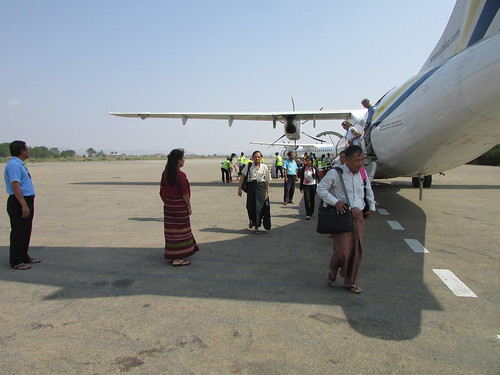
At Heho, the passengers were allowed to walk to the terminal.
The Immigration Desk had two sections - Myanmar residents presented their identity card whilst foreigners had their passport checked. This process was quick and friendly. Checked luggage had been laid out nearby and my luggage receipt was collected and matched against the bag tag before I took possession. I quickly spotted my lady guide by her sign - the agents had me as Mrs. Jam Ford but I thought that rather nice (there's a joke in there somewhere about "Jam Tomorrow") and, after exchanging greetings, we went outside to the car and driver.
We set off on our long journey (about 180 km) initially travelling broadly west towards Kalaw, climbing over a fierce mountain range with many twists and turns. I recognised the important town of Aung Ban which I'd passed through last year on my way from Kalaw to Heho (see post Around Kalaw). I enquired about the station and this time managed to do a quick photographic survey. Aung Ban station is the junction for the line to Loikaw and that line ran close to our onwards route in many places.
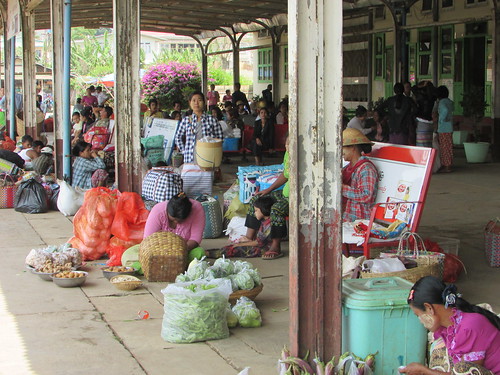
Aung Ban Station
Before reaching Kalaw, we turned south onto Route 54 which ran along the line of the mountain range and gave some spectacular views. The soil is fertile and a wide range of vegetables are grown and exported. In some places, the hills have been terraced for rice growing. In other places Zucchini or courgettes are ground under bamboo frames. I'd seen this on my Thazi to Kalaw train trip last year (described here but not identified the crop. I was amazed that most of the houses seemed to be modern and solidly-built - very few buildings retained woven bamboo panels and new housebuilding was everywhere.
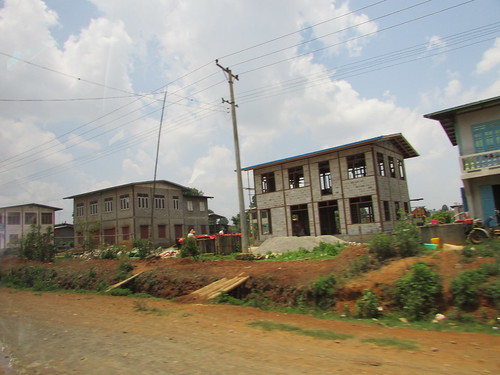
"New housebuilding was everywhere."
Route 54 is one of the many major roads in Myanmar being improved and widened and there was frequent evidence of work in progress. On hilly sections, deep run-off channels were provided for rain water and retaining walls made of stones carefully mortared together were frequent. On one section, two men were delicately painting the mortaring white!
Unexpectedly, there was suddenly a large industrial plant ahead of us - the 'Dragon' Cement Works, owned by a Pa-O businessman, I was told.
We came to a fairly large town, Pin Laung, with an impressive pagoda. Despite the impressive exterior, there was only a tiny temple inside.
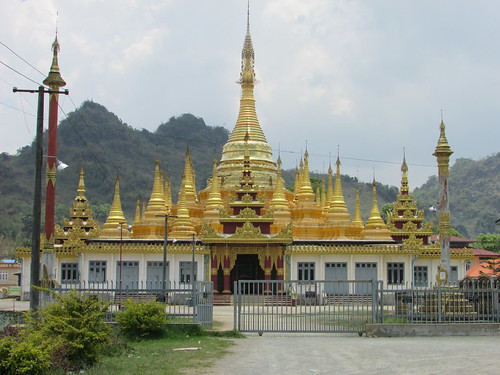
Pin Laung's impressive pagoda.
I'd seen ancient diesel engines driving electric generators in Bagan, where steel ferries were being built using electric arc welding (described in the post Bagan Medical Clinic - Sunday). In Pin Laung, a parked lorry had a similar generator sets coughing away in the load space. A steel frame with four solid, cast wheels mounted what appeared to be the ubiquitous Chinese-made diesel engine with a flywheel driving a Mindong generator (also Chinese-made) through a belt.
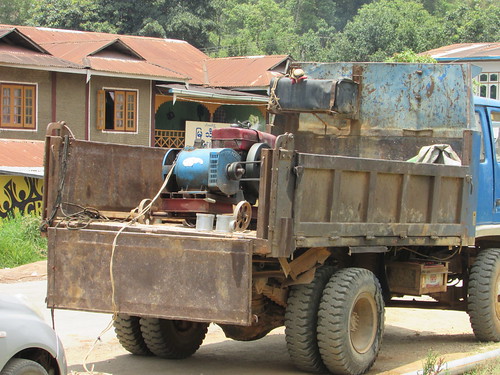
Welding generator mounted on a lorry.
I could see leads dangled off the back of the lorry but couldn't immediately see where they led, until I crossed the road. Two leads (which seemed to me very thin for electric welding) were laid across the tarmac, being run over by the frequent traffic. The leads passed into a trench where a welder was working on steel pipes, watched by his happy mates.
Having passed through the main part of the town, we stopped at a restaurant for lunch where I had a very acceptable steamed rice with fresh vegetables including tomato, cauliflower, carrots and beans, together with a potato and onion soup, all washed down with hot green tea and a slightly cool Coca Cola.
Beyond Pin Laung, the road turned east and descended to the plains. Ahead of us was a huge lake (Moebyel, I think) and we turned south again to run near the edge of the lake. At the town of Phe Khang there appeared to be numerous Catholic churches. One tall hill nearby was topped with a white-painted cross, I imagined in rebuke to a golden pagoda on the opposite side of the valley,
In the plains there were broad rice fields and some water buffalo but there were also farmers with mechanised cultivators. The area produces two rice crops each year.
Without ceremony, we passed a sign saying we had entered Kayah State. A little further on, another sign said we were now in Loikaw. There was a dual carriageway, large educational college, anonymous government buildings and at least two military camps. We turned off into the suburbs and made our way to my home for three days, Loikaw Lodge. Open only eight months, the styling is very modern with large rooms with a balcony overlooking a small lake. To my surprise, I found it all charming.
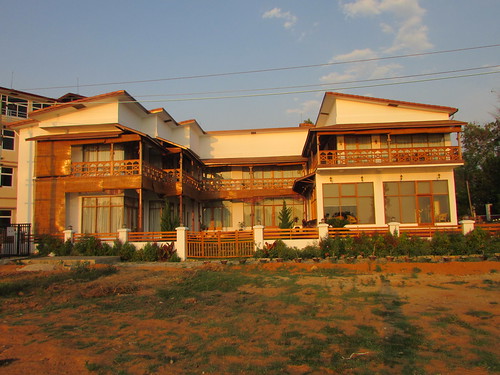
Loikaw Lodge: Viewed from the lake.
Related Posts on this Website
Next Post describing this trip.
All 2017 Burma Trip posts.
My Pictures
Where necessary, clicking on an image above will display an 'uncropped' view or, alternately, pictures from may be selected, viewed or downloaded, in various sizes, from the albums listed:-
Yangon - Heho by air.
Aung Ban Station.
Aung Ban - Loikaw by road.
Aung Ban to Loikaw railway.
Loikaw, Kayah State.
Loikaw Lodge.
[Links to pictures added 24-May-2017, Text amended & pictures added 1-Sep-2017]
